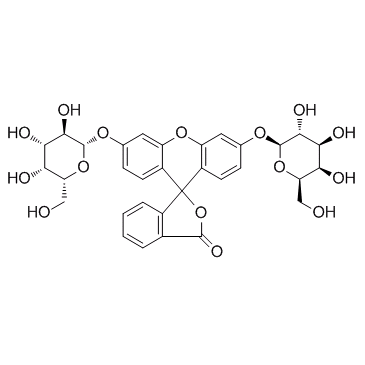Fluorescein di(β-D-galactopyranoside)

Fluorescein di(β-D-galactopyranoside) structure
|
Common Name | Fluorescein di(β-D-galactopyranoside) | ||
|---|---|---|---|---|
| CAS Number | 17817-20-8 | Molecular Weight | 656.58700 | |
| Density | 1.74 g/cm3 | Boiling Point | 974.8ºC at 760 mmHg | |
| Molecular Formula | C32H32O15 | Melting Point | 200-203ºC (dec.) | |
| MSDS | Chinese USA | Flash Point | 316.5ºC | |
Use of Fluorescein di(β-D-galactopyranoside)Fluorescein di(β-D-galactopyranoside) is a fluorogenic substrate for β-galactosidase (λex=485 nm, λem=535 nm). |
| Name | Fluorescein di(β-D-galactopyranoside) |
|---|---|
| Synonym | More Synonyms |
| Description | Fluorescein di(β-D-galactopyranoside) is a fluorogenic substrate for β-galactosidase (λex=485 nm, λem=535 nm). |
|---|---|
| Related Catalog | |
| In Vitro | The fluorescence produced by Fluorescein di(β-D-galactopyranoside) increases in a time- and dose-dependent manner. The level of fluorescence produced by the double-substrate method is much lower than that by the Fluorescein di(β-D-galactopyranoside) method. Results show that the fluorescein produced by Fluorescein di(β-D-galactopyranoside) in Hs68 cells is proportional to the number of passages[1]. |
| Cell Assay | The cells (5×103 cells per well) are cultured in a 96-well plate overnight for attachment, washed, and then fixed in solutions. An aliquot (100 μL) of the reaction buffer (i.e., the staining solution without X-Gal) is added into each well. Then, 10 μL of 2 mM Fluorescein di(β-D-galactopyranoside) is added per well and the plate is incubated in the dark at 37°C for 24 h without CO2 supply. After incubation at 37°C for 24 h, 100 μL of the supernatant is transferred to a 96-well plate for fluorescent measurement in triplicates. The fluorescein fluorescence is measured using a fluorometer with an excitation at 485 nm and an emission at 535 nm[1]. |
| References |
| Density | 1.74 g/cm3 |
|---|---|
| Boiling Point | 974.8ºC at 760 mmHg |
| Melting Point | 200-203ºC (dec.) |
| Molecular Formula | C32H32O15 |
| Molecular Weight | 656.58700 |
| Flash Point | 316.5ºC |
| Exact Mass | 656.17400 |
| PSA | 234.29000 |
| Vapour Pressure | 0mmHg at 25°C |
| Index of Refraction | 1.764 |
| Storage condition | −20°C |
| Personal Protective Equipment | Eyeshields;Gloves;type N95 (US);type P1 (EN143) respirator filter |
|---|---|
| Safety Phrases | 22-24/25 |
| RIDADR | NONH for all modes of transport |
| WGK Germany | 3 |
| HS Code | 32129000 |
|
High-throughput screening with nanoimprinting 3D culture for efficient drug development by mimicking the tumor environment.
Biomaterials 51 , 278-89, (2015) Anti-cancer drug development typically utilizes high-throughput screening with two-dimensional (2D) cell culture. However, 2D culture induces cellular characteristics different from tumors in vivo, re... |
|
|
Quantitative evaluation of DNA damage and mutation rate by atmospheric and room-temperature plasma (ARTP) and conventional mutagenesis.
Appl. Microbiol. Biotechnol. 99 , 5639-46, (2015) DNA damage is the dominant source of mutation, which is the driving force of evolution. Therefore, it is important to quantitatively analyze the DNA damage caused by different mutagenesis methods, the... |
|
|
A programmable microfluidic static droplet array for droplet generation, transportation, fusion, storage, and retrieval.
Lab Chip 15 , 3677-86, (2015) We present a programmable microfluidic static droplet array (SDA) device that can perform user-defined multistep combinatorial protocols. It combines the passive storage of aqueous droplets without an... |
| 3',6'-bis[[(2S,3R,4S,5R,6R)-3,4,5-trihydroxy-6-(hydroxymethyl)oxan-2-yl]oxy]spiro[2-benzofuran-3,9'-xanthene]-1-one |